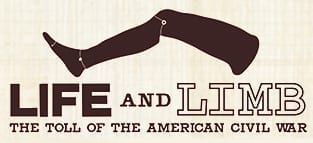
That incredible carnage and tragedy also sparked the beginning of modern military medicine, from the importance of having transportation for soldiers wounded during battle to the eventual realization that bacteria caused infection and the spread of disease. (Two-thirds of the soldiers who died in the war were killed by infectious disease.)
Reminding us of the tragedies of the Civil War and lessons learned is an exhibition on display in the DMU Library through November 12, “Life and Limb: The Toll of the Civil War.” Developed and produced by the National Library of Medicine, National Institutes of Health, the exhibition “explores the experiences of disabled Civil War veterans who served as a symbol of the fractured nation and a stark reminder of the costs of the conflict,” states its website.
The exhibition delves into the horrors of the war and its high number of amputees, thanks to the physical damage caused by ammunition used in battle (which practically guaranteed limb removal) and often-resulting infection. It also discusses the war’s aftermath, including how Americans “increasingly ignored the plight of aging, disabled, impoverished veterans.”
DMU Library displays are free and open to the public, with viewing hours Monday through Friday, 7:30 a.m. to 5 p.m. The library is located on the second floor of the DMU Student Education Center, 3300 Grand Avenue. Be sure to view “Life and Limb” – it’s too important to miss.

